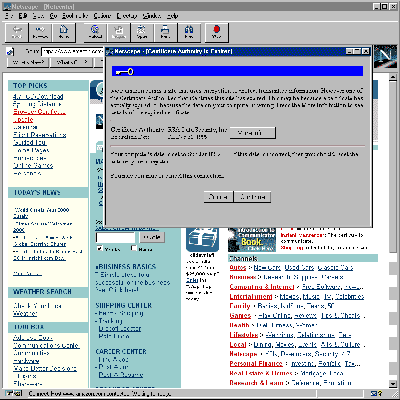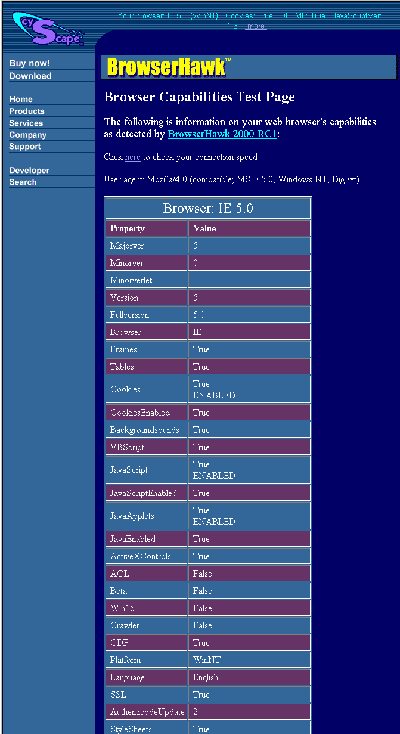Welcome to "The Matrix" ?
Well unless this is the virtual reality of the Matrix that we are living in, then it seems that we have survived the Millennium change over. For now at least. We are sure that there will be a few issues that raise their heads at the end of January as companies do their month end routines. However for now the threatened disaster seems to have been diverted. As far as the web was concerned everything went smoothly, we only had one small problem with a server running a report from WebTrends which started just before midnight. The WebTrends Web Log analyser program hung and had to be manually restarted, a minor irritation but easily fixed. The biggest news was the head-in-the-sand attitude of Netscape. Users of Netscape's browsers up to and including version 4.06 have expiry dates hard coded into the browsers digital certificates, which means that any secure site will refuse them entry. Considering that the code for this browser is public domain and relatively new, it is amazing that such an oversight should occur.

'Where didn't you want to go today?'
As far as we know Netscape were unaware of this, as they did not inform anyone, the first we heard was an email from cyScape, the developers of the excellent browser detection software, BrowserHawk ( http://www.cyscape.com ). This email arrived on the 30th of December at 15:31, talk about finding out at the last minute!

[graphic: browser.gif caption: "We know all about your browser" ]
Just how many IT managers are going to have to explain why the browser on their Boss's laptops stopped working on many sites? Before any of you Microsoft fans (yes there are some) start getting smug on this one. Internet Explorer 4.5 for the Mac has the same problem. A much smaller market sure, but still is an amazing demonstration of the arrogance of big software companies and the lack of quality control in software development. If we are to trust this software to carry us through this new millennium and provide a firm platform to take us forward on to the next step in commerce then we need less emphasis on the gimmicks and the latest 'kweel' feature and more effort into making the core systems reliable. One could argue that the fact that because the millennium change over went so smoothly, this is a vindication on the quality of the software.
This is not the case. Firstly the Millennium was an event that was known about for as long as anything could be. It was only because of the vast amount of effort in testing and applying software fixes, all done using business's own funds that a possible disaster was averted. Some companies forced customers to pay for upgrades to enable their software to work into the next millennium. Perhaps it will set a president that every ten years we shall have to pay for a 'Decade Upgrade'. Absurd? Perhaps, but no more so than a 'Millennium Upgrade'. We were still being sent Y2K patches for software the week before Christmas, hardly a satisfactory situation. Now if these fixes were for programs written 20 years ago then this situation would be understandable. But we are talking about some software that was written only a year ago, still needing to be fixed. How is business to trust this technology to handle its new commercial channels? The answer is that it never has and never will. What any sensible business does, is trust the ability of its IT staff to keep this commercial empire balanced on foundations of software with the stability of the finest jelly. Without doubt it is going to be the quality of the IT staff that will ensure the commercial success of many companies in the future.
There will also need to be a change in attitude for many of these people. It is not going to be acceptable for some IT staff to treat users with contempt, and rather than being in an Ivory tower of their own making, they will need to become more involved in the business process. Perhaps even becoming allies with their old enemy ; - the marketing department.
About Time?
It is almost impossible to talk about the New Year without the subject of New Year Resolutions cropping up. Well we have one for all the developers of Web design tools. Can we please have a design tool that will enable us to use the full power of DHTML easily. When we started this column back in the February 1998 issue we talked about this exciting new development of DHTML. Now nearly two years later there still is not a design tool that enables us to use the full facilities of DHTML. Try and do the hover tag in a style sheet in the newly released Macromedia DreamWeaver 3 for example. You can't. Try to create expanding lists easily. You can just about in Microsoft's Visact, but don't try to alter them too much because all sorts of nasties will occur. Visact seems to be able to help the poor developer with DHTML.
However as it only works on a single page basis and knows nothing about links to other pages nor does it understand about forms and their objects; its a bit like the friend who offers to fix your car claiming that he knows about them, only for you to find that the car now has more problems than when you first gave it to him. What it is good at is DHTML animation, but although the ability to animate is useful, a help at navigation systems would have been much more useful. Even when some of these tools do produce a page that seems to behave the way you want, the amount of HTML produced can be frightening. We have had web pages generated by Visact with 10K of DHTML code just to display a couple of lines of text. If this bloating is the future of web pages, then we are going to need all that extra cheap bandwidth that we are constantly being promised.
This need for more and more bandwidth brings us to another big question. When everything in the IT world drops rapidly in price, why does bandwidth still costs almost the same as it did in 1997? It is a question that Mark has yet to get a sensible answer to whilst talking to several ISPs with reference to a large upgrade in bandwidth that his company is going to need to handle a world wide internet event later this year. If many other ISPs are still paying the same for connectivity from the Telecom providers such as Cable & Wireless and BT then perhaps the shareholders should ask themselves why they should be investing in companies that have so little interest in maximizing their competitiveness by negotiating lower rates from the Telco's . Perhaps as many ISPs are now owned wholly or partly by such Telco's, that there is no desire to reduce rates. If this is the case then some sort of intervention by the Government is called for, to prevent a cartel forming.
The end of BarclayCoin
Some months ago Mark wrote about the Micropayment system called BarclayCoin. Micropayments are a method whereby a web site can offer products or services at amounts less than the minimum credit card transaction value. Such a system would allow a ‘pay per view’ capability on a web site, and for obvious reasons, many conventional publishers are looking at this. Any payment system on the Internet is approached with justifiable caution by most users, and so to have a Micropayment system that was backed by a major international bank such as Barclays was an exciting development. However we now have some sad news. Barclays have discontinued the BarclayCoin system. They have emailed all those who took part in the trial and say in this email ‘that whilst innovative at the time of its launch, there have been a number of technological advances during the last two years and we would like to exploit these in our final solution for micro payment services’. It will be interesting to see what Barclays come up with. We do hope that they don’t ignore this important area of e-commerce, which is crying out for a viable solution, lead by a respected financial institution, so that users will trust it and have the necessary guarantees about the security of their money. It needs a company like Barclays to give it the kick start that many are waiting for.